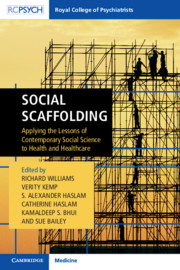Book contents
- Social Scaffolding
- Social Scaffolding
- Copyright page
- Contents
- Contributors
- Foreword
- Note
- Section 1 Schooling
- Section 2 Scoping
- Chapter 6 The Social Determinants of Mental Health
- Chapter 7 Laidback Science: Messages from Horizontal Epidemiology
- Chapter 8 Parity of Esteem for Mental Health
- Chapter 9 Belonging
- Chapter 10 Families and Communities: Their Meanings and Roles Across Ethnic Cultures
- Chapter 11 The Nature of Resilience: Coping with Adversity
- Chapter 12 The Value of Tolerance and the Tolerability of Competing Values
- Chapter 13 Towards Partnerships in Health and Social Care: A Coloquium of Approaches to Connectedness
- Chapter 14 Commentaries on Core Themes in Section 2
- Section 3 Sourcing
- Section 4 Scaffolding
- Section 5 Sustaining
- Index
- References
Chapter 8 - Parity of Esteem for Mental Health
from Section 2 - Scoping
Published online by Cambridge University Press: 14 June 2019
- Social Scaffolding
- Social Scaffolding
- Copyright page
- Contents
- Contributors
- Foreword
- Note
- Section 1 Schooling
- Section 2 Scoping
- Chapter 6 The Social Determinants of Mental Health
- Chapter 7 Laidback Science: Messages from Horizontal Epidemiology
- Chapter 8 Parity of Esteem for Mental Health
- Chapter 9 Belonging
- Chapter 10 Families and Communities: Their Meanings and Roles Across Ethnic Cultures
- Chapter 11 The Nature of Resilience: Coping with Adversity
- Chapter 12 The Value of Tolerance and the Tolerability of Competing Values
- Chapter 13 Towards Partnerships in Health and Social Care: A Coloquium of Approaches to Connectedness
- Chapter 14 Commentaries on Core Themes in Section 2
- Section 3 Sourcing
- Section 4 Scaffolding
- Section 5 Sustaining
- Index
- References
Summary
This book has considered the nature of health and mental health using the definition of the World Health Organization (WHO) and other definitions in Chapter 6. We now move to considering what the term ‘parity of esteem’ means. This chapter brings together thoughts about parity of esteem for mental health and mental healthcare with physical health and physical healthcare, and the way in which that reflects the contents and values in this book. I have spoken at international events about this topic on many occasions.
- Type
- Chapter
- Information
- Social ScaffoldingApplying the Lessons of Contemporary Social Science to Health and Healthcare, pp. 66 - 71Publisher: Cambridge University PressPrint publication year: 2019
References
- 4
- Cited by



